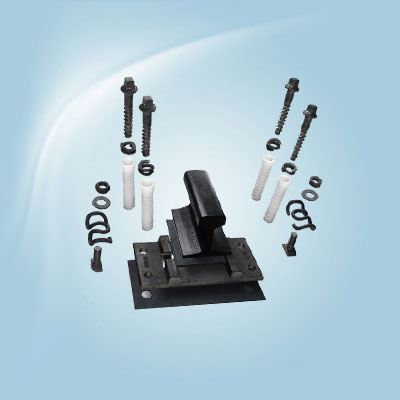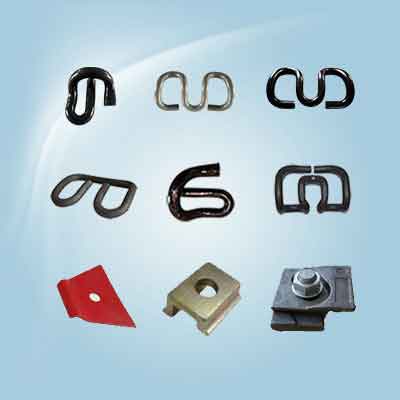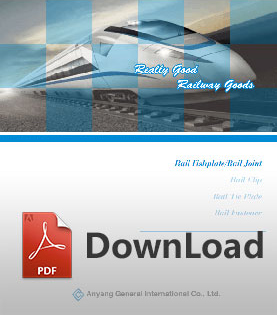Railroad Spike Materials Overview - Carbon Steel and Structural Steel
Feb 03, 2016

In recent times, railroad spike is an indispensable component for ensuring the safety of railway transportation. With the different requirements of railroad spikes, materials are also important in the use of spikes. In railway industry, steel can be worth experimenting with. There are many different types of steel used such as carbon steel, rebar, leaf and coil spring steel etc. Among them, carbon steel and structural steel play an important role for making railroad spikes. So, what materials are railroad spikes made of?
Carbon steel

Carbon steel is the Iron-carbon alloy steel with carbon content less than 2%. Besides the carbon content, there are still a little silicon, manganese, sulfur and phosphorus existed in the steel. Carbon steels are often galvanized, through hot-dip or electroplating in zinc for protection against rust.
According to the application, carbon steel can divided into carbon-structural steel, tool carbon steel and free-cutting structural steels. In the other hand, carbon steel can also be classified into low carbon steel(WC≤0.25%), medium carbon steel(WC0.25%~0.6%) and high carbon steel (WC>0.6%).
Types of carbon steel
- Low carbon steel
Low carbon is the steel whose carbon content less than 0.25%. Low price makes it become the most common form of steel for many different applications. What’s more, the low carbon content makes it ductile and malleable. As to the density, it is usually approximately 7.85g/cm3(7850kg/m3 or 0.284lb/in3). What’s more, low carbon steel has a low tensile strength and surface hardness can be increased through carburizing.
- Medium carbon steel
Medium carbon steel is the steel with carbon content approximately 0.3-0.6%. The features of balances ductility and strength make medium carbon steel widely used for large parts, forging and automotive components.
- High carbon steel
High carbon steel is very strong because of the 0.7-2.5% carbon content. It is mainly used for springs and high-strength wires.
- Ultra-high carbon steel
As we all know, with more than 2.5% carbon content, the steels are always made for using powder metallurgy. In this condition, the steels can be tempered to great hardness, which made it convenient for special purposes such as knives, axles or punches.
Advantages of carbon steel
- Versatile
It’s convenient for you to find carbon steel with various percentages of carbon. The amount of carbon changes the structure of the metal and makes the steel more stronger, pliable and brittle.
Low carbon steel is mostly used for kitchen appliances and cookware as well as the paneling of some car bodies while ultra-high carbon steels are mainly used in industrial cutting blades and equipment for their durability in machinery.
- Naturally safe
Compared with other alloys which should be coated with a substance to ensure the safety, carbon steel doesn’t need to be protected. As a green material, carbon steel has a good nonflammability which makes it become a great product for home and industrial areas. Besides, the rate of recycle and reuse is higher than the combined recycling rate of many other products such as plastic, paper and glass etc.
- Less cost effective
Naturally, the amount of carbon steel used in industry is less than other materials. It is cheaper than other metal like titanium or copper.
Structural steel

Structural steel is a typical category of steel mostly used for making structural steel shapes. As a construction material, the structural steel shape is strictly following certain standards for chemical composition and mechanical properties. There are many types of structural steel used in the industrial areas and the shapes, sizes, composition, strengths, storage practices must be regulated by some special standards.
Typical features of structural steel
- Speed of Construction
With the development of rapid design, fabrication and erection cycle of structural steel, it will be available earlier to other trades. The 3-D interoperability and building information allow some better designs to save both money and time in the construction process. Only with structural steel can achieve the rapid erection with close tolerances being maintained for integration with other building systems and minimal construction site waste.
- Aesthetic Appeal
In the industrial areas, the structural steel does well in the design of their structures to emphasize grace, slenderness, strength and transparency of frame. Compared with other construction materials, structural steel gives a greater degree of expression and creativity for architect in their construction process. During the construction process, architects emphasize grace, slenderness, strength and transparency of frame of structural steel. Structural steel sections can be bent and rolled to create non-linear members to further enhance the aesthetic appeal of the structure.
- Sustainable
Structural steel is one of the most recycled materials and it is made of about 88% recycled product which can be reused without further processing. Besides, the production of structural steel conserves our most valuable water. The water used in the production is the make-up water added to a closed loop recycling process. At the end of their use life, the recycling rate of is more than 100%. Rather than utilizing land for quarrying operations to provide aggregates or as landfills for construction material waste, structural steel is emptying salvage yards allowing that land to be used for other purposes.
You may also like:
- How to choose railroad spike?
- Do you really know screw spike?
- How Much Are Railroad Spikes Worth?
- Why railroad spikes will be corroded?
- Where to find railroad spike?
- How to Protect Railroad Spike from corrosion
- Seasonal and Environmental Impact on Railroad Spikes
- What Are Railroad Spike Made Out Of: the Material and Features
CATEGORIES
- Rail Fasteners
- rail fastening system
- rail clip
- railroad spike
- Track bolt
- rail shoulders
- rail anchor
- rail clamp
- tie plate
- Rail Pad
- rail insulator
- rail plastic dowel
- other rail fasteners
- Railway Switch
- SKL series rail fastening system
- Chinese standard rail fastening system
- screw spikes
- Crane rail fastening system
- K type rail clip for Africa
- Hey-Back Rail Fastening
- rail fasteners for Mexican market
- Ss25 screw spike
- Ss35 rail sleeper screw spike
- Ss8 screw spike
- coach screw
- Crane Rail Clip
- Rail Joints (Fishplate)
- Steel Rail
- Railway Sleeper
Hot Sale Products
rail fastening system
 rail clip
rail clip
 rail joints
rail joints

Product Brochure
Product Brochures,Instant FREEDownload
We Respect Your Email Privacy,We Hate Spam As Much As You Do!
 Español
Español English
English
